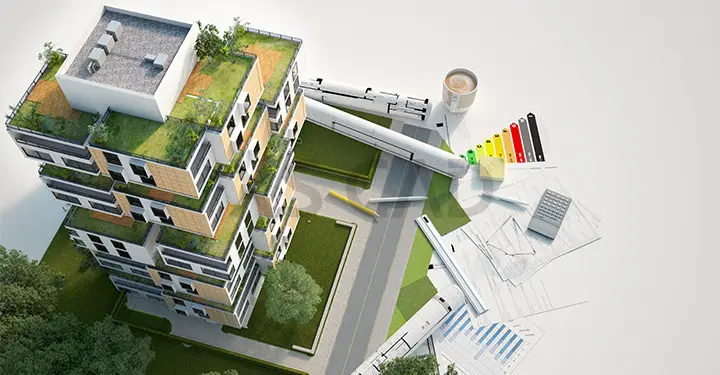Our Articles

Fly Ash – Another Brick in the Wall for Greener Buildings
It’s a win-win equation for the construction industry and the environment, a distinct rarity. The construction industry has come under repeated fire for environmental damage in countless ways – construction waste, air, water/ soil pollution and the release of tonnes of carbon dioxide into the atmosphere. In fact, carbon dioxide has been calculated to contribute up to 26% of all greenhouse gases* plaguing the environment. In addition to the reduction of carbon dioxide emission, the use of fly ash bricks in construction has introduced a range of environmental benefits. As the world moves towards developing green buildings, the manufacture and increasing the use of fly ash bricks in construction has the potential to effect substantial environmental change.
The basic ideology of fly ash brick technology is the manufacture of climate-friendly bricks without using coal for the process. Traditional brick-making burns large amounts of coal and results in the emission of tonnes of carbon dioxide every year. Also, valuable topsoil is used for the manufacture of clay bricks. If fly ash brick use is adopted on a global scale, it has the potential to eliminate carbon emissions from the brick-making industry.
Understanding fly ash bricks – what they are made of, how they are made and how they are used – is essential to understanding the extent of their benefits. To get right into it, fly ash is an unwanted residue, resulting from coal-fired power plants. Typically, fly ash was disposed on large areas of land, resulting in both environmental damage and human health issues, especially around power plants. An Increasing need for power drove the extensive mushrooming of coal-driven power plants, generating sizeable amounts of fly ash. Decades ago, fly ash bricks were developed without the use of coal. Fly ash is combined with lime and gypsum to produce fly ash bricks.
These bricks can be made in a range of sizes and strengths, perfect for their use in building construction. They need less cement and mortar than clay bricks. Cement wall plastering on exterior walls is not required when using fly ash bricks, as they are grey, already have a smooth, uniform texture and absorb substantially less water than other bricks. Lighter in weight than other bricks, fly ash bricks can be easier to transport. In addition, fly ash bricks do not require to be fired in huge kilns, a process for clay brick production that requires large amounts of burning coal, which adds to the greenhouse gas effect. This means that they do not contribute to environmental pollution.
Recognising their far-reaching impact, the World Bank is supporting a project to promote fly ash brick technology by granting entrepreneurs the chance to earn carbon credit revenues. A carbon credit is a certificate declaring that a company has paid to have the equivalent of one tonne of carbon dioxide or equivalent greenhouse gas removed from the environment. More than one hundred fly ash brick plants have earned close to $3.2 million*.
So, how does it work?
Traditionally, bricks were made with clay and sand or soil moulded together and dried and burnt. Burning these bricks used a considerable quantity of fossil fuel, which then generated carbon dioxide, contributing to global warming. A method called FaL-G, or Fly ash Lime-Gypsum, replaces the soil ingredient of traditional clay brick manufacture with fly ash. The bricks are made at room temperature, instead of over 2000F (for clay bricks), thus eliminating the generation of greenhouse gases. By preventing fly ash from being deposited on land, this method reduces water, air and soil pollution. In addition, human health benefits include the reduction of respiratory ailments of residents near power plants.
The quality of clay bricks had been deteriorating for some time, due to the poor quality of topsoil used to manufacture them. The FaL-G brick method has produced strong bricks. They can be created in different sizes and strengths and can speed up the construction process, while saving mortar. Here’s how:
Fly ash and water are compressed at 4000psi and then cured for 24 hours in a steam bath. The bricks are then toughened with an air-entrainment agent. Due to a high concentration of calcium oxide, the bricks can be considered self-cementing. This method saves energy and reduces mercury pollution in the environment.
Materials used to create fly ash bricks include:
Once manufactured, fly ash bricks enable a host of benefits.
Benefits of Fly Ash Bricks
Fly Ash Properties that Are Advantageous in Construction
Since green buildings are also defined by their energy consumption, one of the additional advantages of using fly ash bricks is its ability to provide effective thermal insulation. This means that buildings consisting of fly ash bricks are cool in summers and warm in winters, reducing the energy consumption of the buildings.
Even sounds are more effectively absorbed, since fly ash bricks are sound absorbent and restrict sound transmission, making interiors quiet. Fly ash bricks also have high fire resistance, making them a great choice of material for fire prevention services.
All these advantages have enabled the use of fly ash bricks in factories, warehouses, power plants, as well as homes and high-rise buildings. With the right architectural CAD services support, especially from accurate, experienced and cost-effective drafting services in India, homes and other buildings around the world can be designed to effectively use fly ash bricks to their advantage in creating ‘greener’ buildings.

